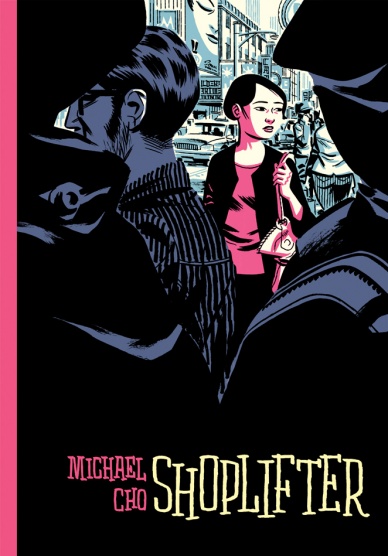
Michael Cho‘s debut graphic novel, “Shoplifter“, is a bit more relatable for me than it likely is for others. That’s not to say it’s not wholly relatable to large portions of its potential audience, though. It’s about twenty-something English literature student turned ad copy writer Corinna Park, a young woman who struggles with feelings that she’s wasting her time with often futile efforts to maintain a life she hardly likes, let alone loves. It’s a pretty universal feeling, that wayward sense of drifting through your life, especially (and strangely) in today’s culture where technology has created an immersive global environment that is inescapable, mostly by choice.
But for me, it’s a lot more specific. I went to college with the very vague idea of studying creative writing, but when I realized I could write with whatever degree I earned, I pursued degrees in two different business disciplines instead. They were means to an end – guaranteed funding to my future career writing, naturally – that ended up becoming my means and end, as I’m now a 30 year old working at an advertising agency (in online and social media, not copywriting) that moonlights as a comic journalist.
Naturally, I see a lot of myself in Park, a woman who exists as an everyman in many ways. But Park as a character is much more than just a placeholder for this (or any) reader’s fantasy fulfillment, and it’s through her journey that Cho’s story becomes such a winning, poignant exploration of finding yourself amidst the noise and pressure of modern society.
Part of the trick of taking a subject as universal as this one – the pains of finding yourself and your path – and making it viable and interesting in a flush market of similar stories is building a world to ground it in. Cho’s city, which was never specifically identified but probably is supposed to be New York, is a great start, as the world Park interacts with – from the club setting pretentious parties are held at to the crowded, overly marketed streets she walks on – feel developed enough to feel lived in yet generic enough to not push a reader out. One of Cho’s greatest talents as an artist is in depicting cityscapes, and you can see that throughout as he takes the occasional meditative page to slow down the pace and give us a look at where Park resides. It gives him a chance to add some true eye candy to the book while also providing a place for Park to get introspective. It’s a nice narrative touch, and a good looking one at that.
The cast of characters Park deals with can be boiled down to archetypes in some ways, but even that plays into what Cho is looking to deliver. One of my favorite ideas in this story is the idea that advertising isn’t just a concept used for products today, but for people too, as each of the people Park interacts with are pushing their personal brand in all facets of their life. It doesn’t matter if you’re a visionary advertising guru, a staff secretary or a photographer looking to move to New Mexico to get away from it all, Cho’s exploration of these characters as not just people, but pitchmen of their own very existence, is very fascinating and stunningly real. Especially so in today’s era of internet celebrities and self-curated lives via social media.
Those characters and their frequently superficial relationships with Park also help make one character and his impact on Park’s life all the more effective, as sometimes it’s the most unassuming, unexpected people who really, truly know you.
Park herself is the heart and soul of this book, though, and it works because of how well Cho depicts her and her struggle to find herself. From an art standpoint, I love what Cho does with her. He’s a very expressive artist, and Park’s face wears all of the emotions her life drags her through. I love the little touches Cho delivers, like the bashful lines that form under her eyes as she departs a party with a very special number, or the casual innocence she portrays as she earns her titular reputation. Cho is never over the top with those expressions, though, grounding her life and her environment without taking the air out of it. His two tone art was an excellent choice as well, as it keeps the focus on the story and not on any stylistic flashes or flourishes.
Continued belowHer character arc in this story is beautifully handled, and while it’s not one that is necessarily saying something new, there’s something to be said about confident, capable storytelling making the old feel…maybe not new, but certainly inviting again. Her wayward existence is relatable and sometimes heartbreaking, but that doesn’t mean there isn’t room for charm. I love Cho’s depiction of her relationship with her cat, as it is fun and could be viewed as a barometer for her life – how could Anais love her if she can’t love herself? – and Cho gives Park a fierce sense of intelligence that comes out in many different ways. On occasion, it comes with claws that would make Anais jealous.
Park’s the type of lead who you can’t help but root for, as she pushes to find herself in the miasma of a life and lifestyle that isn’t what she wants for herself, and Cho delivers that arc in appealing, inviting fashion.
All in all, Cho’s first foray into full-length graphic novel storytelling is a hugely successful one, and one that proves that Cho the writer can offer the same humanity and beauty that Cho the artist can. “Shoplifter” is an insightful, hopeful read, and one that has a lot to offer the wayward spirit in each and every one of us.
Michael Cho’s “Shoplifter” is on sale September 2.



